
Let us know what you’re watching today.

Let us know what you’re watching today.
Enjoy…

Jarvis Jones could be a top five pick. Injury concerns could also force him down the board.
Jarvis Jones is an incredible football player. In two years at Georgia he’s amassed 24 sacks, flashing elite skills as a pass rusher and athletic qualities worthy of a top five pick. Yet something lingers in the background. Something that could really hamper his ambitions of playing in the NFL.
Spinal stenosis is a pretty serious condition which affects a number of football players, including Jones. It’s defined as an abnormal narrowing of the spinal canal that may occur in any of the regions of the spine. The narrowing causes a restriction to the spinal canal, resulting in a neurological deficit. Symptoms can include pain, numbness, paraesthesia and loss of motor control.
Some of the biggest names in the sport have been affected by the condition. Here are just a select few cases:
– Cooper Manning – older brother of Peyton and Eli – was diagnosed with the condition in 1992. It ended his career. Archie Manning had both other brothers tested immediately afterwards due to the severity of the issue. Neither had the condition.
– Michael Irvin retired in 1999 after receiving advice from doctors. He was diagnosed with spinal stenosis after suffering a non-life-threatening spinal injury in a game against the Philadelphia Eagles. The injury cut short a Hall of Fame career.
– Marcus McNeill was diagnosed with the condition prior to the 2006 NFL draft and it forced his fall into round two. One of the most talented offensive lineman to enter the league in recent memory was the seventh tackle to leave the board that year. At the age of just 28 he has been forced to retire, despite signing a six-year, $49 million with the Chargers after an impressive start to his pro career.
– Chris Samuels was the #3 overall pick in 2000, having built a reputation blocking for Shaun Alexander at Alabama. He spent nine years with the Washington Redskins before retiring aged 32. The reason? Samuels suffered temporary upper-body paralysis after a big hit in pass protection against the Carolina Panthers in 2009. The issue was blamed on spinal stenosis, a condition he was diagnosed with as a child. He was advised to cease playing immediately.
– Speculation suggested Rob Gronkowski had spinal stenosis after a series of back problems during his college career in Arizona. Agent Drew Rosenhaus was forced to deny the reports from NFLDraftScout.com prior to the 2010 draft. There were fears the talk could further push Gronkowski’s stock down the board, with lingering concerns over his back already leading to a second round fall.
In 2009, Jarvis Jones was playing for the USC Trojans against Oregon. He suffered a pretty routine hit, but Jones stayed on the turf with a neck injury and was pulled out of the game as a precaution. Doctors diagnosed a mild case of spinal stenosis.
USC advised Jones to stop playing football and refused to clear him for contact. His career was effectively over in Southern Cal. It was a huge blow – Jones had travelled across the country to play for Ken Norton Jr. and Pete Carroll. Both believed they had found the next great Trojan linebacker. ESPN’s Jordan Conn interviewed Norton Jr. and asked about Jones: “A lot of guys have speed, but they’re not tough. Then some guys are tough but slow. Then there are guys who have all of that but no football smarts or work ethic. Jarvis has it all. It’s not even fair.”
On the injury: “It seemed like just a regular linebacker injury, I don’t think any of us thought it’d be as serious as it turned out” notes Norton Jr. It was his last act for USC’s football programme.
Not surprisingly for a young man with so much talent and ambition, he didn’t take no for an answer. While USC were unwilling to clear him to play, other teams might be willing. Georgia coach Mark Richt forced Jones into a series of tests and examinations and the doctors cleared him to play for the Bulldogs. He’s since developed into a college football star in its most high profile conference.
Jones may face a similar situation when he turns pro. Some teams will likely adopt the approach of USC and strike his name off the board. Given the chance to speak to Jones, they may even recommend he retires to avoid serious injury. Others will take advice from doctors and if they’re given the green light, will probably look at the big plays, 20+ sacks in two years and elite athleticism and take the chance. The question is, will one of those teams take a chance in the top ten? Or will they take the chance in round two?
We’ve assumed for so long that Jones would be a high pick due to his on-field performance, but this is something we’ll have to consider seriously as we edge closer to the draft. The condition was bad enough to force Marcus McNeill into round two, but it wasn’t bad enough to stop him enjoying a productive career until the age of 28. Jones actually has another year of eligibility at Georgia, but if he turns pro in 2013 he’ll be a 24-year-old rookie. Will a team roll the dice on a top-ten pick for a talented player who might only play 4-6 years in the league? All the while risking serious injury?
It’s worth noting that there haven’t been any issues at Georgia and Jones hasn’t just played, he’s dominated. That creates a real dilemma for scouts and GM’s at the next level. He has the condition, however mild. Are you willing to be the team that puts the guys health at risk? Or do you listen to the doctors, see his body of work in college and go with a player of immense talent?
With a clean bill of health, he probably would’ve had three years at USC and waltzed into the league as a top pick. We’d be watching him on Sunday’s right now. Unfortunately that isn’t the case. And however much we enjoy watching him play for Georgia, it doesn’t necessarily mean he’s going to be the high pick everyone expects. This condition has impacted players before and it could have an impact on Jarvis Jones come next April.
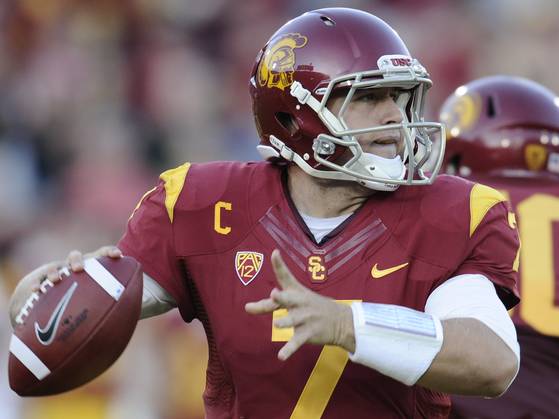
Despite some difficult moments this year, a quarterback like Matt Barkley could still go #1 overall
The draft is a slightly different animal since the new CBA was signed. The rookie wage cap has revolutionised the NFL, making the #1 pick a worthwhile possession rather than a hindrance. Sam Bradford – the final #1 overall pick before the new rules kick in – signed a contract worth $78m with $50m in guarantees. With an updated CBA in place, Cam Newton and Andrew Luck both agreed deals worth a fully guaranteed $22m. Teams don’t need to fear a JaMarcus Russell-style titanic mistake anymore.
With that in mind, there’s scope for a bad team to do whatever it takes to get a kick start. Indianapolis choosing Andrew Luck was pretty much a no-brainer. Carolina drafting Cam Newton? Not so much.
The Panthers had the #1 pick but no quarterback. They could’ve gone in many different directions. Lot’s of pundits had them taking Nick Fairley, a defensive tackle. Or Von Miller, a pass rusher. Or Patrick Peterson, a cornerback. In the end, they decided they needed a quarterback at all costs. They went through the list (four quarterbacks were taken in the first twelve picks) and chose Newton. That was point one of the rebuild. Like many teams, the Carolina Panthers were going to build around a quarterback.
Which team would’ve taken Newton had Carolina gone with, for example, Von Miller? I would guess he’d still be on the board at #8 where Tennessee took Jake Locker. He may have survived beyond that.
I think there are similarities between 2011 and the forthcoming draft in April. There are a handful of really talented defensive prospects. There isn’t a clear ‘superstar’ quarterback gaining rave reviews like Andrew Luck or Robert Griffin III. If the Kansas City Chiefs have the #1 pick they’ll be in the same situation as Carolina. They’ll face a choice of best player vs a launch pad quarterback. And I suspect they’ll take a quarterback.
The question would become who do they take? Newton was an easier choice in 2011 due to his outstanding physical talents. Matt Barkley, Geno Smith, Tyler Wilson etc don’t boast those same qualities. Yet anyone watching the Chiefs recent defeat to Pittsburgh can identify where Kansas City’s problems lie. They don’t have a terrible roster. They’ve got some nice pieces on defense and some playmakers on offense. They compete in a pretty open AFC West division. They just need a quarterback who can bring everything together.
While I accept none of the quarterbacks eligible for 2013 probably deserves to be the #1 overall pick based 0n performance this year, I think it’s stll likely to be the direction Kansas City goes if they have the choice.
When we get into December I’ll start the weekly mock draft updates and we’ll run through different alternatives for the Seahawks. For now, I’m sticking with the same pick as last time. This offense continues to utilise the run as its focus and that will always be the case with Pete Carroll as Head Coach. He appears to want a big strike passing game and Darrell Bevell is becoming increasingly creative to make that happen. Across the board they like multi-faceted athletes who can contribute in a number of different ways. So the pick once again this week is Tennessee’s Cordarrelle Patterson.
Receiver is considered less of a need nowadays, but the Seahawks could still use another playmaker. I did consider Arthur Brown (LB, Kansas State) – a player Carroll is familiar with. I also considered the remaining defensive tackles, Robert Woods, the two Stanford tight ends and cornerback Jonathan Banks. However, I do think they’ll look at ways to aid Wilson’s progression in year two. A receiver in Seattle might only make two passes in a game, but he’ll come away with 50-60 yards and a touchdown. That’s the big strike passing offense for you. Patterson has got the potential to be a home run hitter – to make two big plays in a game if not the 10-catch performance we’re unlikely to ever see in this system.
I’ve included a round two at the bottom. Please don’t read too much into the selections there – it’s really just a review of the next tier of prospects.
Updated first round mock draft
 |
#1 Matt Barkley (QB, USC) Watching KC’s game against Pittsburgh, it’s obvious this team needs a quarterback. They need to identify which is the best and draft them. |
 |
#2 Damontre Moore (DE, Texas A&M) He’s been incredible this year and leads the NCAA with 12.5 sacks. The Jaguars have no pass rush. |
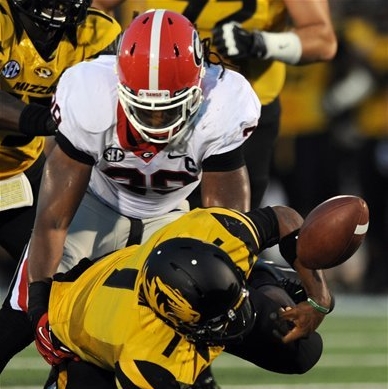 |
#3 Jarvis Jones (DE, Georgia) Explosive playmaker but there are some concerns about his health following the injury that led to his departure from USC. |
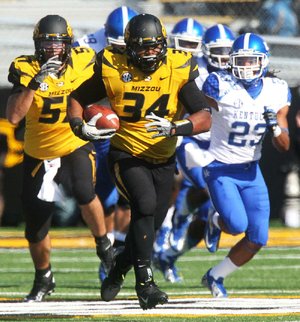 |
#4 Sheldon Richardson (DT, Missouri) Prototypical three technique interior pass rusher. The Panthers run a variety of 4-3 and 3-4 looks but Richardson can adapt to both. |
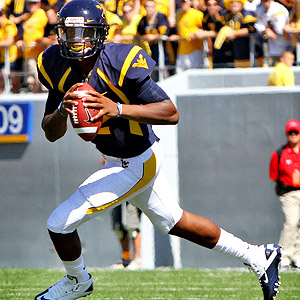 |
#5 Geno Smith (QB, West Virginia) Buffalo’s GM keeps telling the media Ryan Fitzpatrick isn’t a franchise quarterback. So it’s not hard to guess what they might do here. |
 |
#6 Chance Warmack (G, Alabama) The Raiders just need to start drafting good football player. Warmack will be a top NFL guard in year one. |
 |
#7 Luke Joeckel (T, Texas A&M) He’s played well enough this year to move into top ten consideration. |
 |
#8 Jonathan Cooper (G, North Carolina) The Eagles need to sort out their offensive line. Cooper is athletic enough to play tackle or guard. |
 |
#9 Barkevious Mingo (DE, LSU) If the Jets do go defense here, Mingo makes a lot of sense. They need a great edge rusher. |
 |
#10 Alec Ogletree (LB, Georgia) Incredible athlete with untapped potential as a pass rusher. Ogletree could be great. There are some off-field concerns. |
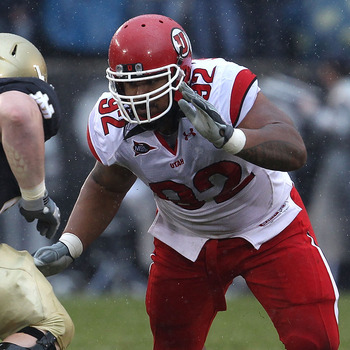 |
#11 Star Lotulelei (DT, Utah) Huge upside but he can be very inconsistent. |
 |
#12 Manti Te’o (LB, Notre Dame) Great player with a few lingering off-field concerns. On the field though he’s a leader and a playmaker. |
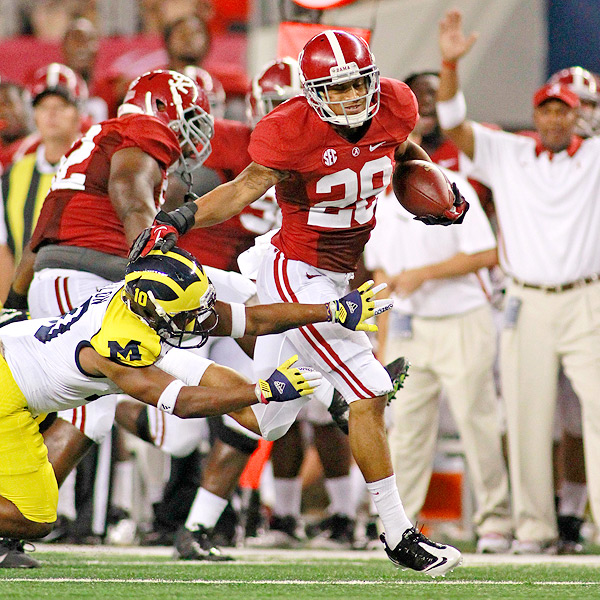 |
#13 Dee Milliner (CB, Alabama) Anyone who gets Dee Milliner outside the top ten is getting the steal of the draft. |
 |
#14 Bjoern Werner (DE, Florida State) He needs to add weight again. At his 2011 size he’s a J.J. Watt clone. That’s his ceiling. |
 |
#15 Brandon Coleman (WR, Rutgers) If he declares (big if) he’ll be by far the most talented receiver in the 2013 draft. |
 |
#16 Ezekiel Ansah (DE, BYU) Ansah will test well at the combine and work his way into the top-20 picks. |
 |
#17 Jake Matthews (T, Texas A&M) He could be better than team mate Luke Joeckel, but doesn’t get quite as much credit playing right tackle. |
 |
#18 Dion Jordan (DE, Oregon) Amazing athlete who’s still learning to become a rounded pass rusher. |
 |
#19 Bradley Roby (CB, Ohio State) He’s gradually overtaken Jonathan Banks as the #2 ranked corner in this class. |
 |
#20 C.J. Mosley (LB, Alabama) It’s the same thing every week – C.J. Mosley making big plays for Alabama. |
 |
#21 Matt Elam (S, Florida) Top-15 talent who lasts this long only due to a lack of need earlier. Elam’s a true playmaker in the secondary. |
 |
#22 Cordarrelle Patterson (WR, Tennessee) Multi-faceted playmaker who will score touchdowns in many different ways. He’s also 6-3 with electric speed. |
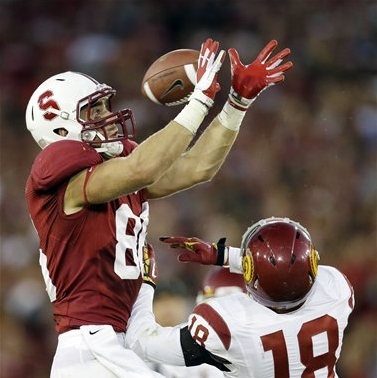 |
#23 Zach Ertz (TE, Stanford) The Steelers can afford to draft a tight end here and Ertz is getting a lot of top-20 talk at the moment. |
 |
#24 Jonathan Jenkins (DT, Georgia) If you need a guy to build a 3-4 defense around, here’s you man. |
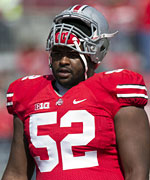 |
#25 Johnathan Hankins (DT, Ohio State) Secondary is a bigger need but the value doesn’t fit here. Hankins is scheme diverse. |
 |
#26 Sylvester Williams (DT, North Carolina) He’s only still on the board due to age. Former JUCO transfer approaching his mid-20’s. |
 |
#27 Robert Woods (WR, USC) He’s a better player than this placing. Expect Woods to land on a good team that can look for value. |
 |
#28 Jesse Williams (DT, Alabama) Williams is the kind of player that belongs on a team with attitude. |
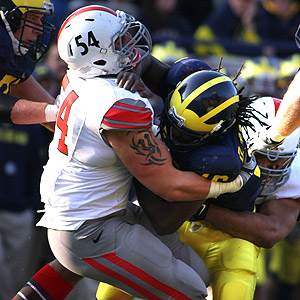 |
#29 John Simon (DE, Ohio State) Blue collar player that’ll boost Baltimore’s pass rush. |
 |
#30 Dallas Thomas (G, Tennessee) Thomas was so impressive against South Carolina and Jadeveon Clowney. He could play tackle or guard. |
 |
#31 Tavon Austin (WR, West Virginia) He’s a playmaker and Houston could shoot for value here. |
 |
#32 Levine Toilolo (TE, Stanford) Putting a 6-8 red zone threat alongside Julio Jones and Roddy White makes sense to me. |
Possible round two
#33 Jacksonville – Taylor Lewan (T, Michigan)
#34 Kansas City – Jonathan Banks (CB, Mississippi State)
#35 Carolina – Xavier Rhodes (CB, Florida State)
#36 Buffalo – Justin Hunter (WR, Tennessee)
#37 Philadelphia – Sam Montgomery (DE, LSU)
#38 Washington – Arthur Brown (LB, Kansas State)
#39 New York Jets – Eric Fisher (T, Central Michigan)
#40 Cincinnati – Giovani Bernard (RB, North Carolina)
#41 St. Louis – Oday Aboushi (T, Virginia)
#42 Tennessee – Kenny Vaccaro (S, Texas)
#43 San Diego – Brennan Williams (T, North Carolina)
#44 Miami – Keenan Allen (WR, California)
#45 Dallas – Tyler Wilson (QB, Arkansas)
#46 Arizona – Tyler Bray (QB, Tennessee)
#47 Detroit – Jordan Poyer (CB, Oregon State)
#48 Cincinnati – Chase Thomas (LB, Stanford)
#49 Tampa Bay – Shawn Williams (S, Georgia)
#50 Minnesota – Shariff Floyd (DT, Florida)
#51 New York Giants – Tyler Eifert (TE, Notre Dame)
#52 Seattle – Gavin Escobar (TE, San Diego State)
#53 Miami – Corey Lemonier (DE, Auburn)
#54 Pittsburgh – Cornellius Carradine (DE, Florida State)
#55 New England – Markus Wheaton (WR, Oregon State)
#56 Green Bay – Jawan Jamison (RB, Rutgers)
#57 Denver – Khaseem Greene (LB, Rutgers)
#58 San Francisco – Alex Okafor (DE, Texas)
#59 Chicago – Bennie Logan (DT, LSU)
#60 Baltimore – Eddie Lacy (RB, Alabama)
#61 Houston – T.J. McDonald (S, USC)
#62 Atlanta – Kawann Short (DT, Purdue)

Russell Wilson deserves more hype as a candidate for rookie of the year
Kerry Byrne wrote a pretty interesting piece this week, asking (or demanding) “Where’s the hype for Russell Wilson?”
“In Luck’s last five games, the period during which the hype has begun to ratchet up, he’s thrown just 3 TD passes with 4 INTs. Wilson over the last five games: 10 TD, 2 INT. On what planet is Luck the better quarterback, given those numbers over the past few weeks. Luck certainly has the potential and the pedigree to be a Hall of Famer. Griffin III is the most talented athlete in the group and gave the hottest start to his career. But through Week 10, Wilson has been the deadliest, certainly most consistent, definitely the hottest right now and, yes, even the best rookie quarterback in football.”
It’s a compelling argument. I’ve watched three Indianapolis games this year, a couple of Washington games and four Miami games. I can see why people get carried away with Andrew Luck – he’s close to being the perfect young quarterback. He’s athletic, he’s accurate, he has ideal size and mobility, he scores highly for character and leadership. It’s only a matter of time until Indianapolis hosts playoff games again and Luck will probably top Peyton Manning’s solitary Super Bowl victory with the Colts.
Yet right now, on November 14th 2012, Russell Wilson is the better player.
What’s more, I’m not convinced Luck’s ceiling is much higher than Wilson’s. The one thing holding Wilson back in the draft process was the much-talked about height issue. Here we are, ten games into the season, and it’s had virtually no impact. Once you take away the height chatter, what’s the difference between the two players? Every quality Luck has, Wilson either matches or beats. He’s athletic, he’s accurate, he has the mobility and he scores highly for character and leadership. The only thing Luck dominates is the hype factor.
As Byrne writes, part of this is down to the ‘storyline’. People love to see expectations met and Luck had been expected to be great ever since he completed his sophomore season at Stanford. The Chuck Pagano angle is adding to the Hollywood nature of this script. The story will inevitably end with a Super Bowl victory against the odds – if not this year, then certainly in the future. And who would begrudge Pagano or Luck that success? Not me.
Wilson hardly had any expectations as a 5-11 quarterback taken in the third round. He was the story of pre-season at a time when virtually everything else was decided. Unless he turned Seattle into a Super Bowl contender as some (Bill Simmons) projected, he was never going to truly challenge Luck and Robert Griffin III for headlines once the proper football began. It means a different story of a battle against the odds remains untold.
Give Luck some credit because he’s playing without a lot of the key factors required to challenge. The Colts defense isn’t great. They don’t have a dominating ground game. This is pretty much the same roster that went 2-14 last season. For years Indianapolis relied on Peyton Manning and Peyton Manning alone. Now they might be about to rely on Andrew Luck. It’s working so far, but they’ll have to build up that roster pretty quickly.
Wilson has the benefit of a franchise that spent two years rebuilding and re-tooling. He can lean on Marshawn Lynch and big investments on the offensive line, at receiver and at tight end. The Seahawks have a top-tier defense. At the same time, he’s still playing at an unusually high level for a rookie quarterback. For that, Wilson deserves some of the limelight.
The crazy thing is, this year could’ve been even better for Wilson and the Seahawks. He has eight interceptions, but that includes an ‘arm punt’ against Arizona, a crazy day in St. Louis where all three picks could be blamed on other people and a juggled catch-turned-interception by Marshawn Lynch against Carolina. All quarterbacks have tough breaks so this is nothing unique or an excuse. Yet we’re talking about five interceptions out of eight. The other three were all Wilson – either a bad decision or poor execution. For the record, he’s thrown 253 passes this year. Three picks that were truly his fault and he hasn’t exactly had many near misses. He’s been the very picture of efficiency, while still flashing big plays.
What attention did Wilson get for out-duelling Tom Brady with a three touchdown performance, including a fourth quarter comeback? Or for mastering a victory over Rex Ryan – a coach with a legit track record against rookie quarterbacks? The same Rex Ryan who embarrassed Andrew Luck and the Colts recently?
Luck has a very mediocre game against Jacksonville – probably the worst team in the NFL – and he’s celebrated like a champion. One of Luck’s three defeats this year came against the same Jaguars outfit.
I don’t think there’s any question that these two players will be compared time and time again during their careers. Perhaps more so than Luck and Griffin III. After a brilliant debut against Washington, RGIII has been mostly efficient with moments of brilliance. The big problem is the Redskins don’t have the scope to build around their prized asset. Without a first round pick until 2015, how are Washington going to repair their offensive line, improve the secondary, add playmakers and bolster the front seven? This is the type of quandary Seattle and Indianapolis don’t have to consider. Griffin III has avoided turnovers but has also made some questionable decisions – including taking avoidable hits with reckless play. He’ll have to learn to protect himself better. And while he’s clearly capable of greatness on any given play, can he show the same level of unflappable consistency we’re seeing from Luck and Wilson?
Ryan Tannehill didn’t impress me much in college and I remain sceptical now he’s in Miami. He’s had some good games. He’s also shown the same kind of issues we saw at Texas A&M – bad decisions, avoidable picks, tipped passes by the dozen. After nine games he’s scored just five touchdowns. Five. That’s compared to nine interceptions. He’s struggled in the red zone and Sunday’s beat-down at home to struggling Tennessee compounded the reality check. That’s not to say he won’t grow and develop. After all, he has a worse current situation than even Griffin III. Washington at least has the patented Mike Shanahan running game. The Dolphins have Reggie ‘one week on, one week off’ Bush and nothing at receiver. However, Tannehill has got a better press than his performances warrant. He’s still showing a lot of the concerns highlighted at Texas A&M and will need to improve to justify the #8 overall pick.
Brandon Weeden is the other rookie starter and like Tannehill is faced with an unfavourable situation. Mike Holmgren did his best in Cleveland and actually made some good choices along with GM Tom Heckert. They’ve also made some questionable calls. At the time, trading down for a bounty of picks to allow Atlanta to get Julio Jones seemed like a smart move. Now, I bet Browns fans would rather have Weeden throwing to Julio. Cleveland essentially had an opportunity to build an offense around Jones and fellow Crimson Tide playmaker Trent Richardson. Instead, they’ve thrown Weeden in to pass to Greg Little and the raw but talented Josh Gordon. The decision to trade away Julio Jones will go down as a classic example of a team overvaluing picks vs talent.
Weeden’s already 29 and needed a fast start to warrant any level of first round investment. Unfortunately, the Browns are 2-7. While Weeden hasn’t been truly awful (he’s had his moments), he needed more than numbers to prove his worth. He needed wins. This was a ‘win now’ selection. You don’t draft a soon-to-be 30-year-old quarterback for the future. Whether it’s Weeden’s fault or not, he had to come out swinging and winning. It was probably always an impossible task and destined to fail.
The Seahawks played a waiting game to get their quarterback and so far, got the best of the bunch. Whether Wilson can remain the best will be a tall order, especially given the huge potential in Luck and Griffin III. But so far, he deserves to be ranked at #1 among this quintet of quarterbacks and a serious contender for rookie of the year. He won’t win it, but he probably should.
Tuesday links
Dan Kadar at Mocking the Draft has an updated draft order following week 10 of the NFL season. The Seahawks are listed at #21 although I think they should be at #22 due to strength of schedule. New York shares the same win/loss record, but the Giants have a weaker SOS (Seattle’s .459 vs New York’s .439).
Tony Pauline has some interesting nuggets of information via Draft Insider.net. He reports that Johnathan Hankins is likely to declare despite pressure from Urban Meyer to return to Ohio State. Pauline also says he’s been told Tyler Bray and Justin Hunter will both turn pro, but Cordarrelle Patterson is expected to stay at Tennessee for another year. If Bray and Hunter head for the NFL, I’m not sure what benefit Patterson will get from sticking around under a new regime. Georgia quarterback Aaron Murray is also going to turn pro, according to Pauline’s sources.
Andy Bitter reports that Logan Thomas will submit paperwork to the NFL draft committee. It’s an interesting development after Thomas had previously announced his intention to return to Virginia Tech. He might get second thoughts if he gets a positive report, especially in a year without a large group of top end first round quarterbacks. He’s had a tough season for the Hokies, but has the physical tools NFL teams drool over.
Kevin Wiedl at ESPN/Scouts Inc has a take on Tyler Wilson and E.J. Manuel. On Wilson: “It’s clear Wilson has the physical tools to entice teams into giving him a late-first-round grade. There is still work to be done on his character and leadership qualities, but based on the tape and what I saw in person, Wilson likely will get into that first-round discussion.” On Manuel: “Overall Manuel looks more like a mid-round developmental prospect than a franchise-type quarterback.”

The Seahawks are generating a serious Ozzie Newsome vibe...
Only a few teams are truly in a position to draft the absolute best player available. After all – what if the best player is a quarterback and you already own a franchise signal caller? That’s an extreme example, but the good teams in the NFL frequently find themselves with a much wider pool of players to choose from because they don’t have glaring needs to fill.
Here’s a list of Baltimore’s recent first round picks dating back to 2006:
Haloti Ngata, Ben Grubbs, Joe Flacco, Michael Oher, Jimmy Smith.
Only one of those players (Ngata) was a top fifteen pick. The Ravens traded down (and then back up) to take Flacco at #18. In 2010 and 2012 GM Ozzie Newsome traded out of the first round before drafting Sergio Kindle and Courtney Upshaw respectively. They’ve also been able to find key offensive contributors in round two, such as Ray Rice and Torrey Smith.
As you can see, the Ravens do a good job in the draft.
Out of all the picks, Flacco is the most aggressive, ‘need-filling’ selection. The Ravens had to get a quarterback in 2008 and made the necessary moves to get it done. The rest of the picks were pretty simple – they were the best players on the board regardless of need. Baltimore’s had a great defense for a generation and for the most part a pretty good offense. And without needing to constantly reach to fill glaring holes in round one, they’ve been able to re-stock using the draft.
The Seahawks haven’t had that luxury for some time now and definitely not since Pete Carroll and John Schneider arrived in Seattle. In their first three drafts with the team they had to identify glaring needs, draft accordingly and build up the roster. They had no choice.
In 2010 the Seahawks knew they were going to lose Walter Jones to retirement, creating a huge need at left tackle. They took Russell Okung with the 6th overall choice. Many expected Okung to be the first tackle off the board and a top-five shoe-in (Trent Williams was drafted by Washington at #4) and clearly the Seahawks felt this was a good match of need vs talent. Even so, they were prioritising. They couldn’t afford to go into the season with Sean Locklear as their best option at tackle. They needed to use the draft to fill a need. With Okung available as a sensible option, it probably ended up being a bit of a no-brainer in the Seahawks war room. Even more so once Eric Berry was drafted at #5 by Kansas City – as free safety was clearly another target need in round one.
With a second pick at #14 courtesy of Josh McDaniels, they were eventually able to fill that need. Pete Carroll made safety a priority. A big priority. You better believe he was willing to take Berry at #6 had the Chiefs passed. Although not ideal LEO candidates, both Jean-Pierre Paul and Derrick Morgan were both on the board at #14 and the Seahawks were desperate for a pass rusher after Patrick Kerney’s retirement. No dice – Carroll wanted a safety and Thomas was highly rated. This was another case where need fit with an available talent. Seattle identified two key problems they wanted to solve and drafted accordingly.
One of the missions in season one was to establish a running game, but it never happened. Despite trading for Marshawn Lynch the Seahawks had possession of the #31 ranked rushing offense. It appeared to be the biggest disappointment of the 2010 season for Carroll and he made improving the ground attack a priority. Out went offensive coordinator Jeremy Bates, in came Darrell Bevell and O-line guru Tom Cable. And with Cable clearly having a big say in how they were going to right this ship, Seattle drafted two offensive lineman with their first two picks in the 2011 draft. James Carpenter was the first round choice – a major shock to many at the time. The front office clearly identified Carpenter as a worthy addition, but this was another case of the Seahawks chasing a need. Repairing the line was a huge priority, which is why John Moffitt followed in round three.
Low and behold, the run game improved significantly in 2011 and attentions turned elsewhere. Despite owning a young, vibrant defense – the Seahawks just weren’t creating enough pressure. Chris Clemons made double digit sacks for the second consecutive year, but nobody else on the roster was helping out. Only ten teams had less sacks than the Seahawks. The team zoned in on the pass rushing class of the 2012 draft and were always destined to take a defensive lineman. Despite talk of Mark Barron and Luke Kuechly, this front office was always likely to draft a pass rusher in round one. As it happens, they had their pick of the group when they found themselves on the clock. And they took Bruce Irvin. For the third draft in a row, the front office identified a glaring need and addressed the issue.
Something else happened in April and maybe it was a little unexpected? We now know the Seahawks managed to fill the greatest need of all during the 2012 draft – finding a young quarterback with ‘franchise’ potential.
That accomplishment probably puts Carroll and Schneider ahead of schedule. I think there’s a pretty good chance they were expecting this to be a four draft plan and that they would look to use the 2013 draft to find a quarterback. I also think they would’ve been pretty aggressive in doing so. As much as John Schneider and Pete Carroll admired Russell Wilson, I’m not sure in the build up to the 2012 draft they were completely convinced they would be able to find their long term option at quarterback in round three. Schneider worked in a Green Bay front office that always drafted quarterbacks, without the absolute expectation they would become quality starters. They were essentially buying plenty of raffle tickets. In Seattle, we were seeing the same plan. And the Seahawks might have won the big prize with their first ticket.
I guess the franchise was due some fortune.
Had they not been able to draft Wilson – or had he not enjoyed the success we’ve seen so far – what could’ve happened? Having built up the defense and running game, they were in position to make a run at a quarterback in 2013. That’s assuming Matt Flynn didn’t step in and eliminate the need in the same way Wilson has. Instead, Wilson has shown he could be the future of the Seahawks franchise. And it means that final glaring need – the quarterback – has theoretically been addressed a year in advance.
With a 6-4 record going into the bye week, Seattle is in a strong position to claim at least a wildcard spot. That would give them the #21 pick in next years draft as a worst case scenario (worst record among playoff teams + first round exit). This team is good enough to go deeper into round one, even if it’s unlikely to earn the #31 or #32 pick by reaching the Super Bowl. Either way, it seems likely it’ll be a later first round pick than 2010 and 2012.
Perhaps for the first time in a while, the Seahawks will be in the ‘Baltimore Ravens’ position? Rather than needing to identify one glaring need that must be addressed at all costs, they can perhaps afford to broaden their horizons. They will still likely consider the teams greater needs – at this stage probably DT, LB and WR. But what if that excellent guard or tackle falls? Or that pass rusher who was expected to go in the top-15? Or that cornerback that would look really good on this roster?
That’s the fortunate position the Seahawks are approaching. And when you can start stocking up on talent for depth rather than feeling like you have to draft for need, that’s when you become a contender.

These two guys had a rough day in Seattle
This was a great win. Don’t let anybody tell you otherwise. During the game I noticed people complaining about play calling, a lack of offense and one or two other issues. Quit complaining. The Seahawks handled this game after the early setback of a Jets turnover-touchdown.
Here’s the facts. Seattle’s defense didn’t concede a single point and completely shut down Mark Sanchez, Tim Tebow and co. The offense struggled early on against a good Rex Ryan defense, but that’s to be expected. Check Ryan’s record against rookie quarterbacks because the guy can coach a defense. It took a while for Russell Wilson to get settled today. Eventually, Darrell Bevell found intelligent ways to combat the exotic blitz packages. And in the end Wilson had two touchdowns, Marshawn Lynch had over 100 yards plus a score and the receivers made big plays.
You can linger on a difficult period after the Jets touchdown if you like. Or you can concentrate on some solid in-game adjustments and another great win for the Seahawks.
Wilson continues to show real potential. His two touchdown throws were right on the money. He had a couple of moments where he tried too hard to hold onto the ball and make a play. One led to a touchdown for New York. Yet unlike a lot of young quarterbacks, it didn’t get to him. Anyone who saw Miami’s Ryan Tannehill today saw a rookie throw a pick-six and go on to throw two more interceptions as he tried to force a response. Wilson was unflappable after his turnover. He’s yet to throw a pick at home and now has 15 touchdowns for the year. Get excited.
Sidney Rice and Golden Tate are showing why they can become a very productive tandem for this offense. They aren’t just making plays, they’re scoring touchdowns. A problem area a few weeks ago is becoming a strength. It’s no coincidence that the production has increased as Wilson has settled into the NFL. As the quarterback continues to grow, I suspect we’ll see even more from Rice and Tate.
Marshawn Lynch has over 1000 rushing yards after ten games. Enough said.
On defense, Bruce Irvin is up to seven sacks as a rookie and Richard Sherman continues to play at an elite level. There won’t be a more deserving Pro Bowl debut if Sherman gets to Hawaii this season. The Jets’ offense is one of the worst in the NFL, but it’s good to see the defense as a unit hit back with a shut-out after a couple of difficult games.
The Seahawks can feel very good about their position at 6-4 going into the bye. There are tough games ahead against Miami and Chicago, but these are occasions where you have to prove you belong. There are six games to go and four wins likely gets you into the playoffs as a wildcard. Although the 49ers struggled against St. Louis today, they maintain a 1.5 game lead in the NFC West. San Francisco has Chicago, New Orleans and New England among their remaining opponents, but they also face the Rams again, Miami, Arizona and Seattle on December 23rd. The Niners are getting a lot of breaks again this year (today being a huge example). In terms of the NFC West title, that luck may not run out until 2013.
As for the draft, one thought struck me today. The Seahawks are running more and more trick plays. They’re still throwing downfield and they’re looking for advantages all over the field. In my last mock draft I projected Cordarrelle Patterson (WR, Tennessee) to Seattle. This is a guy who returns kicks, takes snaps at tailback, will take an end around with a throwing option, run downfield routes. He does it all. Watching this offense today, I think he’s even more of an option than I did previously.
Here are Patterson’s numbers: 638 receiving yards, four touchdowns. 553 kick return yards, one 98-yard touchdown. 270 rushing yards, three touchdowns. One pass attempt, complete, for 28 yards. He’s 6-3, 205lbs and will run a good time at the combine.
In the past I’ve thought if anyone drafts Patterson in round one, it’ll be a team in a position to make a ‘luxury pick’. He’ll be a home run hitter. Suddenly, this Seahawks team looks capable of justifying such a pick. And imagine this offense with another explosive receiver? The front office appears to like multi-faceted playmakers with size and speed. Patterson fits the bill.
It’s merely one option at this very early stage. But it’s an option we might need to give greater consideration as we move forward.
I’m told scouts from #Bears & #Seahawks will attend #Army, #Rutgers game on Saturday. #CFB #NFL
— Chris Steuber (@ChrisSteuber) November 10, 2012
You know the drill by now. I wanted to highlight the above tweet from Chris Steuber – the Seahawks again have representation at a Rutgers game. I still maintain Brandon Coleman is the receiver all Seahawks fans should be hoping declares. He has elite potential and he plays for Rutgers. Of course, they could be looking at linebacker Khaseem Greene too. Either way it’s interesting to note.

Stanford's Zach Ertz could be the first tight end off the board next April
Seattle needs to add at least one new receiver at some point in the off-season. The lack of production at tight end, however, has led some to wonder whether that’s an upgradeable position too.
Zach Miller’s numbers this season are not too different to most tight ends in the league. There aren’t a cluster of Gronkowski’s and Graham’s around and we may see a number of ‘copycat’ draft picks as GM’s try to emulate the Patriots and Saints. The thing is, both of those teams have great, Super Bowl winning quarterbacks and elite passing games. The Seahawks – sporting a rookie quarterback and leaning on the ground attack – are not running an offense that is going to be overly generous towards a tight end.
Part of the problem is Miller’s lack of production in Seattle compared to his time in Oakland. Fans feel underwhelmed by a guy who signed a big contract to join the Seahawks. Yet this is actually the greatest example as to why this isn’t a talent issue. Miller averaged 61 receptions per-year between 2008-10 for the Raiders. He has just 43 catches in 24 games for the Seahawks. According to Advanced NFL Stats, Miller has only been targeted 26 times this year with 18 completions. There are 31 tight ends in the NFL with more targets than Zach Miller. According to the websites ‘success rate’ (defined as ‘the proportion of plays in which a player was directly involved that would typically be considered successful’) Miller is ranked 6th in the league ahead of even Gronkowski and Graham. When the Seahawks use Miller, he generally has a positive impact. They just aren’t using him all that much.
In his final year with the Raiders (2010) he was targeted 92 times. That’s quite a substantial drop off compared to this years 26 targets in nine games. Miller is used largely to block and protect and his role within this offense shouldn’t be defined by the number of catches he’s making. And while ideally you’d like his touchdown numbers to be up, in Oakland he had a one score season in 2008 and only had three touchdowns in 2007 and 2009.
Drafting a tight end early will not automatically provide this team with a jolt of production unless they adapt the position to be more productive. And if you’re going to adapt, why not just put the responsibility on Miller? Although the Seahawks use a lot of 2TE sets, we haven’t seen a great deal from Anthony McCoy or Evan Moore. Spending a high pick on the position might be a wasted move whether it’s to compliment or replace Zach Miller.
The one thing that could provoke a change is the cap hit for Miller in 2013. He’s scheduled to eat up $11m in cap room in a year where the Seahawks may feel that money is better spent elsewhere. He could renegotiate his deal, but it’s unlikely he’ll ever see $11m next season whatever happens between now and the new year. Even in the most dramatic scenario where he’s released, is this really a position you spend a first round pick on?
The Seahawks clearly see the importance of the tight end position, which is why they spent $34m on signing Miller in the first place. That could hint towards a more productive role in the future for whoever plays tight end in this system and further investment. Whether it’s worth a first or second round investment remains to be seen. A lot will depend on how the Seahawks rate a relatively mediocre looking 2013 class at the position.
The two Stanford players are probably the most talented – Zach Ertz and Levine Toilolo. Ertz is a solid all-round tight end who blocks well for his size and is capable of making plays in he passing game. Toilolo is a 6-8 beast who has shown he can get downfield – he’s averaging 19 yards per catch this year. At the next level he might struggle to have the same success rate, but he could be a force in the red zone. Tyler Eifert is the latest tight end off the Notre Dame production line and warrants a mid-round grade. One to keep an eye on is Gavin Escobar at San Diego State. Statistically he’s one of the leading tight ends in the nation and he’s more of a pass catcher than blocker. He’s 6-6 and 255lbs and has the best shot to be that modern day athletic, receiving tight end. Dion Sims at Michigan State warrants some attention as a possible second or third rounder.
It’s around about now that the Washington fans bring up Austin Seferian-Jenkins – the NCAA’s leading tight end statistically and future NFL star. He’s not eligible for the 2013 draft and when he enters the league in 2014, it’ll be as a top-ten pick. It’ll be very difficult to keep ASJ in-state unless the Seahawks take major steps backwards next season. Or they make a big move up the board, which almost never happens for a tight end – however talented.
I’ve included three games of tape for Stanford’s Ertz below, vs USC, Notre Dame and Washington.
© 2025 Seahawks Draft Blog
Theme by Anders Noren — Up ↑